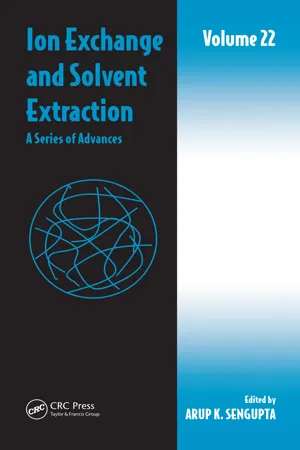![]()
1 | Integrating Tunable Anion Exchange with Reverse Osmosis for Enhanced Recovery during Inland Brackish Water Desalination |
| Ryan C. Smith and Arup K. SenGupta |
CONTENTS
1.1 Introduction
1.1.1 Brackish Water Desalination in the United States
1.1.1.1 Concentrate Management Strategies
1.1.1.2 Scaling Prevention Measures
1.1.2 Ion Exchange as a Pretreatment Method
1.1.3 HIX-RO Process Overview
1.1.4 Previous Research on Ion Exchange-Assisted Desalination
1.1.5 Control of Sulfate Removal by Mixing of Ion Exchange Resins
1.1.6 Reduction in CaSO4 Scaling
1.1.7 Goals and Objectives
1.2 Background on Ion Exchange Chemistry
1.2.1 Determination of Resin Separation Factor from the Selectivity Coefficient
1.2.2 Theoretical Prediction of Resin Separation Factor for Two Mixed Resins
1.3 Experimental Methods
1.3.1 Ion Exchange Resins
1.3.1.1 Sample Analysis
1.3.1.2 Resin Capacity Measurement
1.3.1.3 Batch Sulfate/Chloride Isotherms
1.3.1.4 Column Sulfate/Chloride Isotherms
1.3.1.5 Scanning Electron Microscopy
1.3.2 HIX-RO Runs
1.3.3 Measuring CaSO4 Precipitation Kinetics
1.3.4 In-Column CaSO4 Precipitation
1.4 Results/Discussion
1.4.1 Classification of Resin Properties Affecting Sulfate Selectivity
1.4.2 Experimental Measurement of Individual Resin Separation Factor
1.4.3 Experimental Measurement of Mixed Resin Separation Factors
1.4.4 Results from HIX-RO Runs
1.4.4.1 Mixed Bed Polystyrene and Polyacrylic Resins
1.4.4.2 Pure Polystyrene with Triethylamine Functional Groups
1.4.5 Characterization of Potential for In-Column Precipitation of CaSO4
1.4.5.1 Measurement of CaSO4 Precipitation Kinetics
1.4.5.2 Small-Scale In-Column Precipitation Study
1.4.5.3 Explanation for Lack of In-Column Precipitation
1.5 Conclusions
Acknowledgments
References
For inland desalination plants, managing and discarding produced brine leftover can involve significant operating costs. By increasing the recovery of the desalination process, brine volume and disposal costs can be reduced. However, achieving higher recovery is not immediately viable, as the process involved has a higher potential for calcium sulfate precipitation, which, during reverse osmosis (RO) processes, can foul and eventually damage the RO membrane.
Ion exchange may be used as a pretreatment method to selectively remove and replace sulfate by chloride to eradicate any threat of fouling. The RO process can then be operated at higher recoveries without any threat of sulfate scaling because of the removal of sulfate by the ion exchange column. After RO, the leftover concentrate, highly concentrated chloride brine, can be used as a regenerant for the ion exchange column without requiring the purchase of additional chemical regenerant. By changing the type and/or mixing together characteristically different ion exchange resins, the selectivity of the ion exchange column can be precisely tuned to remove sulfate regardless of the feedwater composition.
Results demonstrate that a properly designed hybrid ion exchange–reverse osmosis system can effectively eliminate the potential for CaSO4 scaling sustainably without requiring external regenerant. The selectivity of the ion exchange resin has a significant role in controlling sulfate removal, and it is possible to precisely predict how the resin selectivity changes depending on the solution composition or mixing ratio with another resin.
1.1 INTRODUCTION
1.1.1 BRACKISH WATER DESALINATION IN THE UNITED STATES
Throughout the United States, 71% of the population receives its drinking water from surface water sources such as lakes and streams.1 However, in recent years, surface and groundwater resources have been declining.2,3 Because of anthropogenic climate change, temperatures in arid regions such as the US Southwest have been increasing, resulting in reductions in precipitation. In the future, water availability in this region will decline.4 As a result, the desalination of previously untapped saline water sources is now being considered as an option for supplying water to arid regions.5–,6,7,8 In these cases, standard methods of drinking water treatment are unable to reduce the total dissolved solids (TDS) content enough for human consumption and advanced desalination treatment methods are required.9 As of 2006, the United States produces approximately 5.6 million m3/day of drinking water by desalination.10 Currently, there are approximately 250 desalination plants operating within the United States with most located in Florida, California, and Texas.11 Of all the desalination facilities in the United States, 65% use brackish water sources. Brackish water refers to water that has a TDS content of ...
